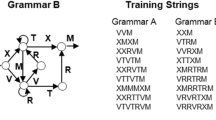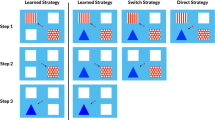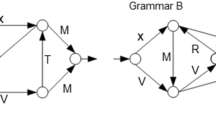Abstract
Humans and nonhuman primates can learn about the organization of stimuli in the environment using implicit sequential pattern learning capabilities. However, most previous artificial grammar learning studies with nonhuman primates have involved relatively simple grammars and short input sequences. The goal in the current experiments was to assess the learning capabilities of monkeys on an artificial grammar-learning task that was more complex than most others previously used with nonhumans. Three experiments were conducted using a joystick-based, symmetrical-response serial reaction time task in which two monkeys were exposed to grammar-generated sequences at sequence lengths of four in Experiment 1, six in Experiment 2, and eight in Experiment 3. Over time, the monkeys came to respond faster to the sequences generated from the artificial grammar compared to random versions. In a subsequent generalization phase, subjects generalized their knowledge to novel sequences, responding significantly faster to novel instances of sequences produced using the familiar grammar compared to those constructed using an unfamiliar grammar. These results reveal that rhesus monkeys can learn and generalize the statistical structure inherent in an artificial grammar that is as complex as some used with humans, for sequences up to eight items long. These findings are discussed in relation to whether or not rhesus macaques and other primate species possess implicit sequence learning abilities that are similar to those that humans draw upon to learn natural language grammar.










Similar content being viewed by others
References
Abe K, Watanabe D (2011) Songbirds possess the spontaneous ability to discriminate syntactic rules. Nat Neurosci 14:1067–1173
Arciuli A, Simpson IC (2012) Statistical learning is related to reading ability in children and adults. Cogn Sci 36:286–304
Attaheri A, Kikuchi Y, Milne AE, Wilson B, Alter K, Petkov CI (2015) EEG potentials associated with artificial grammar learning in the primate brain. Brain Lang 148:74–80
Chomsky N (1956) Three models for the description of language. IRE Trans Inf Theory 2:113–124
Chomsky N (1959) On certain formal properties of grammars. Inf Control 2:137–167
Christiansen MH (in press) Implicit statistical learning: a tale of two literatures. Top Cogn Sci
Christiansen MH, Chater N (2015) The language faculty that wasn’t: a usage-based account of natural language recursion. Front Psychol 6:1182
Christiansen MH, Chater N (2016) Creating language: integrating evolution, acquisition, and processing. MIT Press, Cambridge
Christiansen MH, Conway CM, Onnis L (2012) Similar neural correlates for language and sequential learning: evidence from event-related brain potentials. Lang Cogn Proc 27:231–256
Cleeremans A, McClelland JL (1991) Learning the structure of event sequences. J Exp Psychol Gen 120:235–253
Cleeremans A, Destrebecqz A, Boyer M (1998) Implicit learning: news from the front. Trends Cogn Sci 2:406–416
Conway CM, Christiansen MH (2001) Sequential learning in non-human primates. Trends Cogn Sci 5:539–546
Conway CM, Christiansen MH (2005) Modality-constrained statistical learning of tactile, visual, and auditory sequences. J Exp Psychol Learn 31:24–39
Conway CM, Christiansen MH (2009) Seeing and hearing in space and time: effects of modality and presentation rate on implicit statistical learning. Eur J Cogn Psychol 21:561–580
Conway CM, Bauernschmidt A, Huang SS, Pisoni DB (2010) Implicit statistical learning in language processing: word predictability is the key. Cognition 114:356–371
Cornish H, Dale R, Kirby S, Christiansen MH (2017) Sequence memory constraints give rise to language-like structure through iterated learning. PLoS ONE 12(1):e0168532
De Resende BD, Ottoni EB, Fragaszy DM (2008) Ontogeny of manipulative behavior and nut-cracking in young tufted capuchin monkeys (Cebus apella): a perception–action perspective. Dev Sci 11:828–840
de Vries MH, Christiansen MH, Petersson KM (2011) Learning recursion: multiple nested and crossed dependencies. Biolinguistics 5:10–35
Emberson LL, Conway CM, Christiansen MH (2011) Timing is everything: changes in presentation rate have opposite effects on auditory and visual implicit statistical learning. Q J Exp Psychol 64:1021–1040
Endress AD, Dehaene-Lambertz G, Mehler J (2007) Perceptual constraints and learnability of simple grammars. Cognition 105:577–614
Endress AD, Carden S, Versace E, Hauser MD (2010) The apes’ edge: positional learning in chimpanzees and humans. Anim Cogn 13:483–495
Fagot J, Cook RG (2006) Evidence for large long-term memory capacities in baboons and pigeons and its implications for learning and the evolution of cognition. Proc Natl Acad Sci 103:17564–17567
Fiser J, Aslin RN (2001) Unsupervised statistical learning of higher-order spatial structures from visual scenes. Psychol Sci 12:499–504
Fiser J, Aslin RN (2002) Statistical learning of higher-order temporal structure from visual shape sequences. J Exp Psychol 28:458–467
Fitch WT, Friederici AD (2012) Artificial grammar learning meets formal language theory: an overview. Philos Trans R Soc B 367:1933–1955
Fitch WT, Hauser MD (2004) Computational constraints on syntactic processing in nonhuman primates. Science 303:377–380
Fitch WT, Friederici AD, Hagoort P (2012) Pattern perception and computational complexity: introduction to the special issue. Philos Trans R Soc B 367:1925–1932
Frank SL, Bod R (2011) Insensitivity of the human sentence-processing system to hierarchical structure. Psychol Sci 22:829–834
Frost R, Armstrong BC, Siegelman N, Christiansen MH (2015) Domain generality vs. modality specificity: the paradox of statistical learning. Trends Cogn Sci 19:117–125
Gomez RL, Gerken L (1999) Artificial grammar learning by 1-year-olds leads to specific and abstract knowledge. Cognition 70:109–135
Hauser MD, Glynn D (2009) Can free-ranging rhesus monkeys (Macaca mulatta) extract artificially created rules comprised of natural vocalizations? J Comp Psychol 123:161
Hauser MD, Newport EL, Aslin RN (2001) Segmentation of the speech stream in a non-human primate: statistical learning in cotton-top tamarins. Cognition 78:B53–B64
Heimbauer LA, Conway CM, Christiansen MH, Beran MJ, Owren MJ (2012) A serial reaction time (SRT) task with symmetrical joystick responding for nonhuman primates. Behav Res Methods 44:733–741
Herbranson WT, Shimp CP (2008) Artificial grammar learning in pigeons. Learn Behav 36:116–137
Hunt R, Aslin RN (2001) Statistical learning in a serial reaction time task: access to separable statistical cues by individual learners. J Exp Psychol Gen 130:658–680
Inoue S, Matsuzawa T (2009) Acquisition and memory of sequence order in young and adult chimpanzees (Pan troglodytes). Anim Cogn 12:S59–S69
Jäger G, Rogers J (2012) Formal language theory: refining the Chomsky hierarchy. Philos Trans R Soc B 367:1956–1970
Jamieson RK, Mewhort DJK (2005) The influence of grammatical and local and organizational redundancy on implicit learning: an analysis using information theory. J Exp Psychol Learn 31:9–23
Karlsson F (2010) Syntactic recursion and iteration. In: van der Hulst H (ed) Recursion and human language. Mouton de Gruyter, Berlin, pp 43–67
Kidd E (2012) Implicit statistical learning is directly associated with the acquisition of syntax. Dev Psychol 48:171–184
Kidd E, Arciuli J (2015) Individual differences in statistical learning predict children’s comprehension of syntax. Child Dev 87:184–193
Knowlton BJ, Squire LR (1994) The information acquired during artificial grammar learning. J Exp Psychol Learn 20:79–91
Knowlton BJ, Squire LR (1996) Artificial grammar learning depends on implicit acquisition of both abstract and exemplar-specific information. J Exp Psychol Learn 22:169
Lockhard E (2008) Effects of foraging sequence on the ability of lambs to consume endophyte-infected tall fescue (alkaloids), birdsfoot trefoil (tannins), and alfalfa (saponins). Unpublished doctoral dissertation, Utah State University, Utah
Locurto C, Gagne M, Levesque K (2009) Implicit chaining in cotton-top tamarins (Saguinus oedipus). J Exp Psychol Behav Process 35:116–122
Locurto C, Gagne M, Nutile K (2010) Characteristics of implicit chaining in cotton-top tamarins (Saguinus oedipus). Anim Cogn 13:617–629
Locurto C, Dillon L, Collins M, Conway M, Cunningham K (2013) Implicit chaining in cotton-top tamarins (Saguinus oedipus) (with elements equated for probability of reinforcement. Anim Cogn 16:611–625
Locurto C, Fox M, Mazella A (2015) Implicit learning in cotton-top tamarins (Saguinus oedipus) and pigeons (Columba livia). Learn Behav 43:129–142
Macquart D, Latil G, Beugnon G (2008) Sensorimotor sequence learning in the ant Gigantiops destructor. Anim Behav 75:1693–1701
Menzel R (2009) Serial position learning in honeybees. PLoS ONE 4:e4694
Merchant H, Honing H (2013) Are non-human primates capable of rhythmic entrainment? Evidence for the gradual audiomotor evolution hypothesis. Front Neurosci 7:274
Milne AE, Wilson B, Christiansen MH (2018) Structured sequence learning across sensory modalities in humans and nonhuman primates. Curr Opin Behav Sci 21:39–48
Misyak JB, Christiansen MH (2010) When ‘more’ in statistical learning means ‘less’ in language: individual differences in predictive processing of adjacent dependencies. In: Catrambone R, Ohlsson S (eds) Proceedings of the 32nd annual cognitive science society conference. Cognitive Science Society, Austin, pp 2686–2691
Misyak JB, Christiansen MH (2012) Statistical learning and language: an individual differences study. Lang Learn 62:302–331
Misyak J, Christiansen MH, Tomblin JB (2010) On-line individual differences in statistical learning predict language processing. Front Psychol 1:31
Neiworth JJ (2013) Chasing sounds. Behav Process 93:111–115
Newport EL, Hauser MD, Spaepen G, Aslin RN (2004) Learning at a distance II. Statistical learning of non-adjacent dependencies in a non-human primate. Cogn Psychol 49:85–117
Nissen MJ, Bullemer P (1987) Attentional requirements of learning: evidence from performance measures. Cogn Psychol 19:1–32
Perruchet P, Pacton S (2006) Implicit learning and statistical learning: one phenomenon, two approaches. Trends Cogn Sci 10:233–238
Petersson KM (2005) On the relevance of the neurobiological analogue of the finite state architecture. Neurocomputing 65–66:825–832
Petersson KM, Forkstam C, Ingvar M (2004) Artificial syntactic violations activate Broca’s region. Cogn Sci 28:383–407
Petkov CI, Wilson B (2012) On the pursuit of the brain network for proto-syntactic learning in non-human primates: conceptual issues and neurobiological hypotheses. Philos Trans R Soc B 367:2077–2088
Pothos EM (2010) An entropy model for artificial grammar learning. Front Psychol 1:1–13
Procyk E, Dominey PF, Amiez C, Joseph JP (2000) The effects of sequence structure and reward schedule on serial reaction time learning in the monkey. Cogn Brain Res 9:239–248
Ravignani A, Sonnweber R-S, Stobbe N, Fitch WT (2013) Action at a distance: dependency sensitivity in a New World primate. Bio Lett 9:20130852. https://doi.org/10.1098/rsbl.2013.0852
Reber AS (1967) Implicit learning of artificial grammars. J Verbal Learning Verbal Behav 77:317–327
Redington M, Chater N (1997) Probabilistic and distributional approaches to language acquisition. Trends Cogn Sci 1:273–281
Rey A, Perruchet P, Fagot J (2012) Centre-embedded structures are a by-product of associative learning and working memory constraints: evidence from baboons (Papio Papio). Cogn 123:180–184
Richardson WK, Washburn DA, Hopkins WD, Savage-Rumbaugh ES, Rumbaugh DM (1990) The NASA/LRC computerized test system. Behav Res Methods 22:127–131
Saffran JR (2003) Statistical language learning: mechanisms and constraints. Curr Dir Psychol Sci 12:110–114
Saffran JR, Aslin RN, Newport EL (1996) Statistical learning by 8-month-old infants. Science 274:1926–1928
Saffran J, Hauser M, Seibel R, Kapfhamer J, Tsao F, Cushman F (2008) Grammatical pattern learning by human infants and cotton-top tamarin monkeys. Cognition 107:479–500
Santolin C, Saffran JR (2017) Constraints on statistical learning across species. Trends Cogn Sci. https://doi.org/10.1016/j.tics.2017
Schiff R, Katan P (2014) Does complexity matter? Meta-analysis of learner performance in artificial grammar tasks. Front Psychol 5:1084
Shanks DR, Johnstone T, Staggs L (1997) Abstraction processes in artificial grammar learning. Q J Exp Psychol 50A:216–252
Sonnweber R, Ravignani A, Fitch WT (2015) Non-adjacent visual dependency learning in chimpanzees. Anim Cogn 18:733–745
Spierings M, ten Cate C (2016) Budgerigars and zebra finches differ in how they generalize in an artificial grammar learning experiment. Proc Natl Acad Sci 113:E3977–E3984
Stobbe N, Westphal-Fitch G, Aust U, Fitch WT (2012) Visual artificial grammar learning: comparative research on humans, kea (Nestor notabilis) and pigeons (Columba livia). Philos Trans R Soc B 367:1995–2006
Tabullo A, Sevilla Y, Segura E, Zanutto S, Wainselboim A (2013) An ERP study of structural anomalies in native and semantic free artificial grammar: evidence for shared processing mechanisms. Brain Res 1527:149–160
Terrace HS, Son LK, Brannon EM (2003) Serial expertise of rhesus macaques. Psychol Sci 14:66–73
Washburn DA, Rumbaugh DM (1992) Testing primates with joystick-based automated apparatus: lessons from the Language Research Center’s computerized test system. Behav Res Methods 24:157–164
Wilson B, Slater H, Kikuchi Y, Milne AE, Marslen-Wilson WD, Smith K, Petkov CI (2013) Auditory artificial grammar learning in macaque and marmoset monkeys. J Neurosci 33:18825–18835
Wilson B, Kikuchi Y, Sun L, Hunter D, Dick F, Smith K, Thiele A, Griffiths T, Marslen-Wilson WD, Petkov C (2015a) Auditory sequence processing reveals evolutionarily conserved regions of frontal cortex in macaques and humans. Nat Commun 6:8901
Wilson B, Smith K, Petkov CI (2015b) Mixed-complexity artificial grammar learning in humans and macaque monkeys: evaluating learning strategies. Eur J Neurosci 41:568–578
Zarco W, Merchant H, Prado L, Mendez JC (2009) Subsecond timing in primates: comparison of interval production between human subjects and rhesus monkeys. J Neurophysiol 102:3191–3202
Funding
This research was funded in part by National Institutes of Health Grants HD-38051 and HD-060563, an RCALL seed grant, and the College of Arts and Sciences at Georgia State University. Lisa Heimbauer was an RCALL Fellow during completion of this work.
Author information
Authors and Affiliations
Corresponding author
Ethics declarations
Conflict of interest
Lisa A. Heimbauer declares that she has no conflict of interest. Christopher M. Conway declares that he has no conflict of interest. Morten H. Christiansen declares that he has no conflict of interest. Michael J. Beran declares that he has no conflict of interest. Michael J. Owren is deceased.
Human and animal rights
All research protocols used in this study with the monkeys were approved by the Georgia State University Animal Care and Use Committee (protocol A09031). All applicable international, national, and/or institutional guidelines for the care and use of animals were followed including those in the Guide for the Care and Use of Laboratory Animals. No human participants were involved in this research.
Data availability
The datasets analyzed during the current study are available from the corresponding author on reasonable request.
Rights and permissions
About this article
Cite this article
Heimbauer, L.A., Conway, C.M., Christiansen, M.H. et al. Visual artificial grammar learning by rhesus macaques (Macaca mulatta): exploring the role of grammar complexity and sequence length. Anim Cogn 21, 267–284 (2018). https://doi.org/10.1007/s10071-018-1164-4
Received:
Revised:
Accepted:
Published:
Issue Date:
DOI: https://doi.org/10.1007/s10071-018-1164-4




